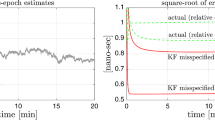Abstract
A new filtering method for a nonlinear system is proposed. The original nonlinear system is reduced to a piecewise linear system through the procedure of ultradiscretization. Then the discrete-time Kalman filter is readily applied to the obtained system by imposing some conditions on system variables and parameters. Some numerical experiments are given to show the efficiency of the method.






Similar content being viewed by others
References
Kalman, R.E.: A new approach to linear filtering and prediction problems. J. Fluids Eng. 82(1), 35–45 (1960)
Jazwinski, A.H.: Stochastic processes and filtering theory. Academic Press, New York (1970)
Tokihiro, T., Takahashi, D., Matsukidaira, J., Satsuma, J.: From soliton equations to integrable cellular automata through a limiting procedure. Phys. Rev. Lett. 76, 3247–3250 (1996)
Quispel, G.R.W., Roberts, J.A.G., Thompson, C.J.: Integrable mappings and soliton equations II. Phys. D 34, 183–192 (1989)
Ramani, A., Grammaticos, B., Satsuma, J., Mimura, N.: Linearizable QRT mappings. J. Phys. A: Math. Theor. 44, 425201 (2011)
Mimura, N., Isojima, S., Murata, M., Satsuma, J.: Singularity confinement test for ultradiscrete equations with parity variables. J. Phys. A: Math. Theor. 42, 315206 (2009)
Takemura, K., Tsutsui, T.: Ultradiscrete Painlevé VI with Parity Variables. Symmetry Integrability Geom. Methods Appl. 9, 070 (2013)
Acknowledgments
The authors would thank Prof. T. Hayashi for useful discussion. They are also grateful to their students, Mr. Shirase, Mr. Ichiki, Ms. Kubota, Mr. Ishigaki, Mr. Arai and Mr. Yomogida for their tentative studies on discrete and ultradiscrete Kalman filter in their graduation or Master theses. This research was supported by JSPS KAKENHI 24560078 and 26790082.
Author information
Authors and Affiliations
Corresponding author
Appendix
Appendix
We derive the three periodic solution (26). If we put \(\alpha =-1\) and \(\beta =1\), (17b) and (17a) reduce to
respectively. Substituting the initial values \((\xi _0, X_0) = (-1,C)\) and \((\eta _0, Y_0) = (1,A)\) into (38a) with \(n=0\), we have
Noting \(B=A+\tilde{B}<2A\), we find that the equation is solved by
Remembering we choose \((\xi _{n+1},X_{n+1})=(-\xi _n, X_n)\) if \((\xi _{n+1},X_{n+1})\) becomes indeterminate, we take \((\xi _1,X_1)=(1, C)\), which actually satisfies (40). Next, substituting \((\xi _1,X_1)\) and \((\eta _0, Y_0)\) into (38b) with \(n=0\), we have
This equation is uniquely solved by \((\eta _1, Y_1) = (-1, C)\). Similarly, we obtain \((\xi _2, X_2)=(1,A)\) (unique), \((\eta _2, Y_2)=(1,C)\) (indeterminate) and further \((\xi _3,X_3)=(-1,C)=(\xi _0,X_0)\) (indeterminate), \((\eta _3, Y_3)=(1,A)=(\eta _0,Y_0)\) (unique).
About this article
Cite this article
Satsuma, J., Isojima, S. Nonlinear Kalman filtering via ultradiscretization procedure. Japan J. Indust. Appl. Math. 33, 227–238 (2016). https://doi.org/10.1007/s13160-015-0206-4
Received:
Revised:
Published:
Issue Date:
DOI: https://doi.org/10.1007/s13160-015-0206-4




